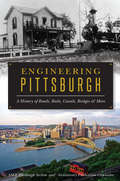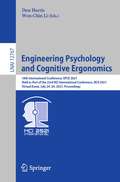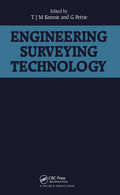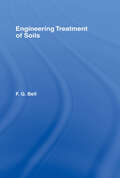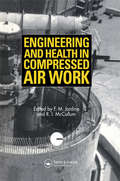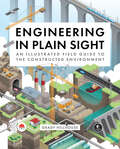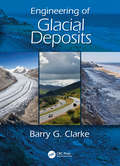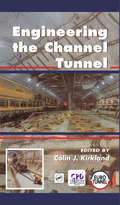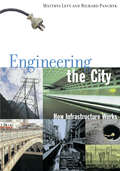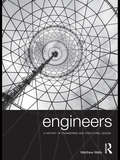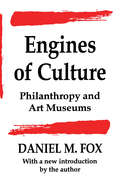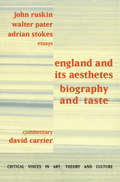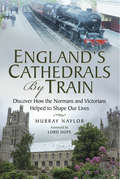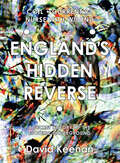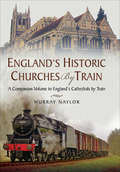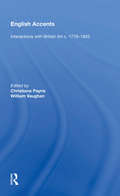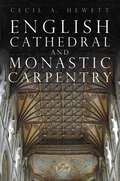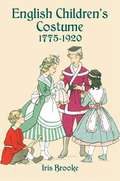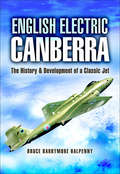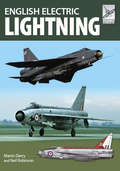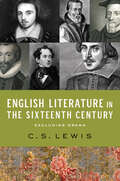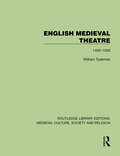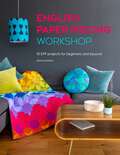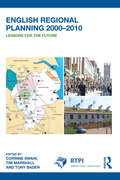- Table View
- List View
Engineering Pittsburgh: A History of Roads, Rails, Canals, Bridges and More
by ASCE Pittsburgh Section 100th Anniversary Publication CommitteeWestern Pennsylvania's infrastructure is renowned for traversing valleys, mountains, rivers and everything in between. Early surveying in the region delineated state and local boundaries that allowed for the mapping of canals, railroads and roadways. Engineers developed bridges, ground transportation systems and airports that linked Pittsburgh to the world. Frequently overflowing rivers transformed into reliable navigation passageways. Drinking water and wastewater treatment systems allowed development and population to flourish, leading to investments in iconic buildings. Join expert civil engineers and professionals as they narrate the story of Pittsburgh and the surrounding region's engineering triumphs.
Engineering Psychology and Cognitive Ergonomics: 18th International Conference, EPCE 2021, Held as Part of the 23rd HCI International Conference, HCII 2021, Virtual Event, July 24–29, 2021, Proceedings (Lecture Notes in Computer Science #12767)
by Don Harris Wen-Chin LiThis book constitutes the proceedings of the 18th International Conference on Engineering Psychology and Cognitive Ergonomics, EPCE 2021, held as part of the 23rd International Conference, HCI International 2020, held as a virtual event, in July 2021.The total of 1276 papers and 241 posters included in the 36 HCII 2021 proceedings volumes was carefully reviewed and selected from 5222 submissions. EPCE 2021 includes a total of 34 regular papers; they were organized in topical sections named: cognitive psychology in aviation; cognitive psychology in air traffic control; studies on cognitive processes; human error and human performance; and cognition and design.
Engineering Surveying Technology
by T.J.M. KennieThis book examines the major changes in the technology now used for the measurement and processing of topographic and non-topographic spatial data, with emphasis on the new and emerging technology and its applications. Fundamental principles are introduced to explain the basic operation of different types of equipment.
Engineering Treatment of Soils
by Fred BellThis book reviews the techniques used to improve the engineering behaviour of soils, either in situ or when they are used as a construction material. It is a straightforward, well illustrated and readable account of the techniques and includes numerous up-to-date references.
Engineering and Health in Compressed Air Work: Proceedings of the International Conference, Oxford, September 1992
by F. M. Jardine R. I. McCallumThis book is the record of the conference held in Oxford in 1992 organised by CIRIA, and co-sponsored by the Health and Safety Executive, The British Tunnelling Society and the Medical Research Council's Hyperbaric Sciences Panel. The book consolidates international medical and engineering knowledge and experience on the use of compressed air and hyperbaric techniques, and looks to how they can be safely used in the future.
Engineering in Plain Sight: An Illustrated Field Guide to the Constructed Environment
by Grady HillhouseEngineering in Plain Sight is a beautifully illustrated field guide with accessible explanations to nearly every part of the constructed world around us.Author Grady Hillhouse is the creator behind the popular YouTube channel Practical Engineering (over 3 million subscribers!) and this book is essentially 50 new episodes crammed between two covers.Engineering in Plain Sight extends the field guide genre from natural phenomena to human-made structures, making them approachable and understandable to non-engineers. It transforms readers' perspectives of the built environment, converting the act of looking at infrastructure from a mundane inevitability into an everyday diversion and joy. Each section of this accessible, informative book features colorful illustrations revealing the fascinating details of how the human-made world works. An ideal road trip companion, this book offers a fresh perspective on the parts of the environment that often blend into the background. Readers will learn to identify characteristics of the electrical grid, roadways, railways, bridges, tunnels, waterways, and more. Engineering in Plain Sight inspires curiosity, interest, and engagement in how the infrastructure around us is designed and constructed.
Engineering of Glacial Deposits
by Barry G. ClarkeAt some time 30% of the world’s land mass was covered by glaciers leaving substantial deposits of glacial soils under major conurbations in Europe, North and South America, New Zealand, Europe and Russia. For instance, 60% of the UK has been affected, leaving significant glacial deposits under major conurbations where two thirds of the population live. Glacial soils are composite soils with significant variations in composition and properties and are recognised as challenging soils to deal with. Understanding the environment in which they were formed and how this affects their behaviour are critical because they do not always conform to classic theories of soil mechanics. This book is aimed at designers and contractors working in the construction and extractive industries to help them mitigate construction hazards on, with or in glacial deposits. These soils increase risks to critical infrastructure which, in the UK includes the majority of the road and rail network, coastal defences such as the fastest eroding coastline in Europe and most of the water supply reservoirs. It brings together many years of experience of research into the behaviour of glacial deposits drawing upon published and unpublished case studies from industry. It draws on recent developments in understanding of the geological processes and the impact they have upon the engineering properties, construction processes and performance of geotechnical structures. Unlike other books on glaciation it brings together all the relevant disciplines in earth sciences and engineering to make it directly relevant to the construction industry.
Engineering the Channel Tunnel
by Colin J. KirklandThe Channel Tunnel may be the greatest engineering project in Europe this century. This book describes the tremendous engineering achievement of the construction of the tunnel. Written by twenty of the key engineers involved, it provides a fascinating, informative and inspiring account of the project for both engineering professionals and general r
Engineering the City: How Infrastructure Works
by Matthys Levy Richard PanchykHow does a city obtain water, gas, and electricity? Where do these services come from? How are they transported? The answer is infrastructure, or the inner, and sometimes invisible, workings of the city. Roads, railroads, bridges, telephone wires, and power lines are visible elements of the infrastructure; sewers, plumbing pipes, wires, tunnels, cables, and sometimes rails are usually buried underground or hidden behind walls. Engineering the City tells the fascinating story of infrastructure as it developed through history along with the growth of cities. Experiments, games, and construction diagrams show how these structures are built, how they work, and how they affect the environment of the city and the land outside it.
Engineers: A History of Engineering and Structural Design
by Matthew WellsThis innovative new book presents the vast historical sweep of engineering innovation and technological change to describe and illustrate engineering design and what conditions, events, cultural climates and personalities have brought it to its present state. Matthew Wells covers topics based on an examination of paradigm shifts, the contribution of individuals, important structures and influential disasters to show approaches to the modern concept of structure. By demonstrating the historical context of engineering, Wells has created a guide to design like no other, inspirational for both students and practitioners working in the fields of architecture and engineering.
Engines of Culture: Philanthropy and Art Museums
by Daniel M. FoxFirst Published in 2018. Routledge is an imprint of Taylor & Francis, an Informa company.
England and its Aesthetes: Biography and Taste (Critical Voices in Art, Theory and Culture)
by David CarrierFirst Published in 1999. Routledge is an imprint of Taylor & Francis, an informa company.
England's Cathedrals by Train: Discover how the Normans and Victorians Helped to Shape our Lives
by Murray NaylorOne of the jewels in the nation's crown is its Anglican cathedrals. Many, constructed after the invasion of 1066, stand as monuments to the determination and commitment of their Norman builders. Others have been built in later centuries while some started life as parish churches and were subsequently raised to cathedral status. Places of wonder and beauty, they symbolize the Christian life of the nation and are more visited today than ever as places which represent England's religious creed, heritage and the skills of their builders.Eight hundred years later came the Victorians who pioneered the Industrial Revolution and created railways. Like their Norman predecessors they built to last and the railway system bequeathed to later generations, has endured in much the same form as when originally constructed. There is little sign that railways will be displaced by other modes of transport, anyway in the foreseeable future,Combining a study of thirty-three English cathedrals and the railway systems which allow them to be reached, the author seeks to celebrate these two magnificent institutions. In the process he hopes to encourage others to travel the same journeys as he himself has undertaken.As seen in The Church Times and Worcester News.
England's Hidden Reverse, revised and expanded edition: A Secret History of the Esoteric Underground
by David KeenanAn expanded edition of the classic exploration of the English esoteric musical underground—with the first biography of Coil, Current 93, and Nurse With Wound.This newly expanded edition of England's Hidden Reverse, the classic exploration of the English esoteric musical underground that includes the first, and only, biographies of Coil, Current 93, and Nurse With Wound, is based on exclusive interviews and unprecedented access to all three bands&’ personal archives. Together, these genre-defying bands and their circles represent the English underground in all its cultural, artistic, and sexual variety. Over four decades, the three intertwined groups have maintained a symbiotic, yet uneasy, relationship with the mainstream of popular culture, even as their music, beliefs, and practices have repelled them from it. Theirs was a clandestine scene whose work accents the many occulted peculiarities of Englishness that flow through generations of outsiders, channeling personalities as diverse as Aleister Crowley, Arthur Machen, Joe Orton, Shirley Collins, Björk, and Marc Almond. The story of this Hidden Reverse has, necessarily, remained a secret. Until now. This new volume contains almost 100 pages of extra material culled from Furfur, a collection of interviews with musicians and artists whose careers intersected with the bands&’, initially published alongside Strange Attractor's first limited edition of the book.
Englands Historic Churches by Train: A Companion Volume to Englands Cathedrals by Train
by Murray NaylorThe second millennium saw the spread and consolidation of Christianity in Britain. One means by which the Normans tightened their grip on Britain after 1066 was by the construction of magnificent cathedrals, thereby demonstrating their intention to remain here. In his earlier book Englands Cathedrals by Train Murray Naylor explained how these hallowed buildings could be reached by train, relating their history and their principal features. His book invited readers to discover how the Normans and Victorians helped to shape our lives, either in constructing cathedrals or inventing railways. Englands Great Historic Churches is the logical follow on to this book. Travelling across England it selects thirty-two of our ancient churches, relating their history and identifying those aspects which a visitor might overlook. His journeys include the great medieval abbeys at Tewkesbury, Selby and Hexham; the less well known priories at Cartmel and Great Malvern and other grand churches severely reduced after the Dissolution of Henry VIIIs reign, notably at Bridlington and Christchurch. He visits a church at Chesterfield where the spire leans at a crooked angle and goes to Boston, where the church - known as the Stump was a starting point for many who emigrated to America in the 17th Century. Pride of place goes to Beverley Minster. In parallel he offers further observations on how railways have developed since the early 1800s and their future.
English Accents: Interactions with British Art c. 1776-1855 (British Art And Visual Culture Since 1750 New Readings Ser.)
by Christiana PayneIn the century following the foundation of the Royal Academy in 1768, British art had an international reputation: prints spread knowledge of the work of British artists around the globe, and it was widely seen as the product of a modern, commercial society, and much admired by artists as diverse as Goya in Spain, Delacroix in France, and Bierstadt in America. In recent years, scholars working on this period have become increasingly aware of the international context of their subject, but there has been no systematic analysis of the reception of British art abroad. This collection of essays looks at the uses made of the paintings of Reynolds, Hogarth, Lawrence and their contemporaries on the continent of Europe, and in the colonies and ex-colonies of Australia and America. The authors go beyond the simple issue of 'influence' to consider how ideas and artistic conventions originating in the British Isles were adapted, appropriated or resisted in these new environments. In the process, some surprising views of British art emerge, demonstrating how a multi-faceted view from the outside can correct and enrich the narrative produced within a national school, and revealing some of the important connections that are obscured when art is studied, as it so often is, within narrow national boundaries.
English Cathedral and Monastic Carpentry
by Cecil A. HewettWell over a hundred great churches were built in the cathedral tradition in the Middle Ages. They are our most important group of historical monuments and embody the finest craftwork of medieval architecture. Despite a great mass of specialist literature and research on other aspects, it was not until Cecil A. Hewett’s work over the past three decades that any serious attention was paid to their functional carpentry or, indeed, to their decorative timberwork.Examining the entire range of ‘great’ churches, Hewett’s carefully reasoned and well-organised text covers all areas of monastic and cathedral carpentry, classifying roof structures, towers and spires in chronological order, while an important section deals with the surviving examples of hoisting machinery still in situ, some from a very early date. In English Cathedral and Monastic Carpentry, he relates the physical evidence to the documentary record supported with over 300 of his own magnificent drawings. In this, Hewett provides both a work of reference and a stimulating analysis of the evolution of the craft.
English Children's Costume 1775-1920
by Iris BrookeLate in the 18th century, English children's apparel began to look different from that worn by their elders. The reason, says writer James Laver in his introduction, is that someone finally realized children were different! This engaging book records those changes, with illustrations depicting styles at five- or ten-year intervals, from 1775 to 1920. 32 black-and-white illustrations.
English Electric Canberra: The History & Development of a Classic Jet (Pen And Sword Large Format Aviation Bks)
by Bruce Barrymore Halpenny&“A useful review of the development of a classic jet bomber that saw widespread service in the Royal Air Force and was exported to many overseas air forces.&” —Aeromilitaria This amazing airplane first flew in 1949 and is still in front-line service with the RAF. It has served in a variety of roles including those of tactical bomber, photo-reconnaissance, navigational trainer, maritime strike, electronic countermeasures and target-towing. It was manufactured in the USA under license as the Martin B-57 and has been exported to Argentina, Chile, India, Peru, South Africa and other Commonwealth countries. This book looks at the development of the aircraft during the early days of jet power and especially at its Rolls-Royce Avon powerplant. Each of the many marks and variants are described and illustrated by many remarkable and rare photographs. The type&’s record of service with RAF squadrons throughout its service life is given together with descriptions of the many experimental models that were used in the development of a variety of weapons and avionic systems. &“For an aircraft that has been the subject of countless books, the author still found a remarkable wealth of previously unpublished material on Canberra operations. A classic aircraft given the proper coverage it so richly deserves.&” —Airfix Model World &“A wonderfully researched tribute to this remarkable achievement, with a plethora of excellent photographs . . . Essential reading for any aviation enthusiast.&” —Pegasus Archive
English Electric Lightning (FlightCraft #11)
by Neil Robinson Martin DerryDeveloped to intercept increasingly capable Soviet bombers such as the Tupolev Tu-16, Tu-22 and Tu-95, the English Electric/BAC Lightning had a phenomenal rate of climb, a high ceiling, and a top speed of over 1,300mph at 36,000ft, and is a favourite of both aviation enthusiasts and aircraft modellers alike.This homage to the only all-British Mach 2 interceptor fighter, follows previous Flight Craft book formats, in that it is split in to three main sections. The first section offers a concise design and development history covering the six main single-seat fighter and two twin-seat trainer Marks; from its first RAF operational squadron deployments in 1960 through to its frontline retirement in 1988, and coverage of the only other two air forces to operate the type, Saudi Arabia and Kuwait. This is followed by a 16-page full colour illustration section featuring detailed profiles and 2-views of the colour schemes and markings carried by the type in RAF, Royal Saudi and Kuwait Air Force service.The final section lists most of the plastic model kits, accessories and decal sheets produced of the EE/BAC Lightning in all the major scales, with photos of finished models made by some of the UK's best modellers. As with all the other books in the Flight Craft series, whilst published primarily with the scale aircraft modeller in mind, it is hoped that those readers who might perhaps describe themselves as 'occasional' modellers, or even simply aviation enthusiasts, may also find that this colourful and informative work offers something to provoke their interests too.
English Historic Carpentry
by Cecil A. HewettA true magnum opus, Cecil A. Hewett’s English Historic Carpentry appeals to every type of architectural historian, from the connoisseur of cathedrals to the vernacular ‘barn and cottage’ enthusiast. It also offers practical insight into the structure and age of the old homes and outbuildings of Britain, and will reveal that much timber-work is appreciably older than their owners might think. This book will be a source of pride and inspiration to all who work in timber today, showing that the master carpenters of the past achieved their highest levels of craftsmanship well before the master masons, and that they were their equals as medieval architects.Beginning as a young upstart with wild theories, Hewett grew to become the accepted authority on all matters of historic carpentry and a pioneer of a whole new technology in the dating of ancient buildings. In English Historic Carpentry, he provides the definite statement of his work, superbly illustrated by his own drawings. As Hewett maintained, ‘the building is the document’ and this book will teach you how to read the evidence that is written in wood.
English Literature in the Sixteenth Century (Excluding Drama)
by C. S. LewisC. S. Lewis offers a magisterial take on the literature and poetry of one of the most consequential periods in world history, providing deep insight into some of the greatest writers of the age, including Edmund Spenser, William Shakespeare, William Tyndale, John Knox, Dr. Johnson, Richard Hooker, Hugh Latimer, Christopher Marlowe, John Donne, and Thomas Cranmer.English Literature in the Sixteenth Century is an invigorating overview of English literature from the Norman Conquest through the mid-seventeenth century from one of the greatest public intellectuals of the modern age. In this wise, distinctive collection, C. S. Lewis expounds on the profound impact prose and poetry had on both British intellectual life and his own critical thinking and writing, demonstrated in his deep reflections and essays. This incisive work is essential for any serious literature scholar, intellectual Anglophile, or C. S. Lewis fan.
English Medieval Theatre: 1400–1500 (Routledge Library Editions: Medieval Culture, Society, & Religion)
by William TydemanOriginally published in 1986, this volume illuminates the predominant theatrical styles of a particular period in dramatic history. It does this by reconstructing – as far as conjecture permits – the manner in which five major plays of the late Middle Ages might have been staged in fifteenth-century Britain. The author draws on his experience in producing medieval plays to discuss the business of staging in a novel way. General conclusions are drawn from specific examples and the qualities which give medieval English drama its idiosyncratic features and appeal are characterized.
English Paper Piecing Workshop: 18 EPP projects for beginners and beyond
by Jenny JacksonDo you love bright, geometric quilt designs but wonder how to get such sharp points and accurate piecing? English paper piecing is the answer and this collection shows you how to sew your own patchwork projects even if you've never made a quilt before. English paper piecing (EPP) is a traditional patchwork technique which uses hexagon-shaped paper templates which are pieced together by hand sewing rather than machine piecing. This process of hand piecing is both mindful and calming and the fact that it doesn't rely on a sewing machine makes EPP the perfect 'sofa sewing' project that can be done while relaxing in front of your favourite TV show or while socialising with friends. Jenny Jackson is an expert in EPP and has been demonstrating the technique and showcasing her patterns on TV craft channels and magazines for a number of years. She has created this collection of techniques and patterns for modern EPP projects for the home including some really striking, large quilts. Jenny holds your hand through the EPP process so, even if you've never tried it before, you can complete projects to be proud of. Even if you already have some experience with EPP, Jenny shares her tips and tricks for quicker and sharper results so you can improve your skills. There are 18 projects for the home in a variety of sizes so you can build up to a full-sized quilt but you can also dip in and out of some smaller projects such as coasters, wall hangings and cushions while you hone your skills. The projects include repeats of EPP patterns and blocks as well as how to use EPP blocks and rosettes as applique within quilts and other projects. It's not just about the hexagon either: Jenny's geometric designs feature 20 different paper pieced templates including diamonds, octagons and even curved shapes for really exciting results. These sheets can be photocopied to give you multiple templates, fast. You can even flex your own creative muscle with the colouring pages included for every project so you can experiment with your own colour combinations to make your own unique designs.
English Regional Planning 2000-2010: Lessons for the Future (RTPI Library Series)
by Tim Marshall Corinne Swain Tony BadenEnglish Regional Planning 2000-2010 chronicles a vital feature of recent UK planning activity, during the period of the Blair and Brown Labour governments up to 2010. It deals particularly with the regional scale of planning during these years, whereby large steps forward were made, but where policy making often proved very controversial. One purpose of the book is to learn from the many areas of policy development, method and skills which evolved during the decade up to 2010. This will mean that a future return to strategic planning should not have to reinvent the wheel. This book also helps to inform such planning in the rest of the developed world where higher-level planning is more prevalent. The book has eight chapters written by experts active in English regional planning during these years, alongside two chapters by the editors introducing and concluding on the experience as a whole. Thematic topics covered include the way in which housing and employment development was tackled in the varying English regional contexts, and the growing influence of transport and environmental factors on the spatial strategy. Process elements covered include how policy was made through public consultation and working with numerous stakeholders (economic, social, environmental), how the public examination of issues was organised, followed by final consideration by central government, and how monitoring informed the next policy review. The authors do not gloss over the difficulties encountered in the highly contested world of English local and regional politics, or the ways in which central government management of the regional planning process made life on the ground difficult for those engaged in the process. Nevertheless the account as a whole shows how a wealth of innovative and forward looking practices were developed. This multi-faceted study contributes to the understanding of how strategic planning can provide the framework for guiding spatial change and allocating resources, looking to a long-term sustainable future.
